AL-QAIDA COMMUNICATIONS
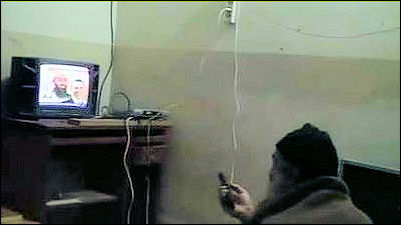
Osama bin Laden watching himself
on TV at his compound in Pakistan The development of sophisticated information technology in the 1990s and the expansion of global travel has made it easier for Al-Qaida to spread is influence around the globe. Before the attack on the World Trade Center in New York on September 11, 2001, Al-Qaida cells communicated via satellite phones, cell phones and e-mail. After September 11th, Al-Qaida became more carefully monitored by intelligence organizations and communication became more difficult.
Al-Qaida has changed their tactics reacting to ways that they are be monitored by intelligence services around the world. Osama bin Laden stopped using his satellite phone by 1998 when it became clear that American intelligence service could easily listen in on his conversation and even use his phone to pinpoint his location for a missile strike. Today messages are often sent in written form or as audio tapes or in flash memories that are hand-delivered or dropped by messengers rather than by direct communications by satellite phone or the Internet. It is believed that Al-Qaida sends coded or hidden messages in video and audio tapes made by Al-Qaida leaders shown on television or on websites.
Al-Qaida members have engaged in cryptic phone conversations using code words like “toy” for pistol, “mute” for a gun silencers, “seven seas” for forged visas, “honey” for CD-ROM with bomb recipes, “little girl” for forged driver license, and “Russian apples” for Russian-made grenades.
Alan Cullison wrote in The Atlantic Monthly: “As al-Qaeda established itself in Afghanistan in the late 1990s and began managing international operations of ever increasing complexity and audacity, the group focused on ensuring the secrecy of its communications. It discouraged the use of e-mail and the telephone, and recommended faxes and couriers. The electronic files reflect the global nature of the work being done; much of the correspondence was neatly filed by country name. Messages were usually encrypted and often couched in language mimicking that of a multinational corporation; thus Osama bin Laden was sometimes "the contractor," acts of terrorism became "trade," Mullah Omar and the Taliban became "the Omar Brothers Company," the security services of the United States and Great Britain became "foreign competitors," and so on. Especially sensitive messages were encoded with a simple but reliable cryptographic system that had been used by both Allied and Axis powers during World War II — a "one-time pad" system that paired individual letters with randomly assigned numbers and letters and produced messages readable only by those who knew the pairings. The computer's files reveal that in 1998 and 1999, when a number of Islamists connected to al-Qaeda were arrested or compromised abroad, the jihadis in Afghanistan relied heavily on the one-time-pad system. They also devised new code names for people and places.[Source: Alan Cullison, The Atlantic Monthly, September 2004, from files found on a computer used by Al-Qaida leader Ayman al-Zawahiri]
Inside Al-Qaida’s Computers
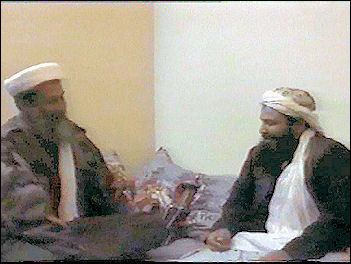
Osama bin Laden in video made after 9-11 In 2001, Wall Street Journal reporter Alan Cullison got into a truck accident that wrecked his computer. While trying to get it fixed he met a man who said he serviced computers belonging to the Taliban and to Arabs in al-Qaeda. Through him he was put in contact with a semiliterate jewelry salesman who for $1,100 sold him two of al-Qaeda's most valuable computers — a 40-gigabyte IBM desktop and a Compaq laptop — which had been looted during the American invasion of Afghanistan. [Source: Alan Cullison, The Atlantic Monthly, September 2004, from files found on a computer used by Al-Qaida leader Ayman al-Zawahiri]
“The desktop computer, it turned out, had been used mostly by Ayman al-Zawahiri, Osama bin Laden's top deputy. It contained nearly a thousand text documents, dating back to 1997. Many were locked with passwords or encrypted. Most were in Arabic, but some were in French, Farsi, English, or Malay, written in an elliptical and evolving system of code words. I worked intensively for more than a year with several translators and with a colleague at The Wall Street Journal, Andrew Higgins, interviewing dozens of former jihadis to decipher the context, codes, and intentions of the messages for a series of articles that Higgins and I wrote for the Journal in 2002.
“What emerged was an astonishing inside look at the day-to-day world of al-Qaeda, as managed by its top strategic planners — among them bin Laden, al-Zawahiri, Atef, Ramzi bin al-Shibh, and Khalid Sheikh Muhammad, all of whom were intimately involved in the planning of 9/11... The documents included budgets, training manuals for recruits, and scouting reports for international attacks, and they shed light on everything from personnel matters and petty bureaucratic sniping to theological discussions and debates about the merits of suicide operations. There were also video files, photographs, scanned documents, and Web pages, many of which, it became clear, were part of the group's increasingly sophisticated efforts to conduct a global Internet-based publicity and recruitment effort.
“The jihadis' Kabul office employed a zealous manager — Ayman al-Zawahiri's brother Muhammad, who maintained the computer's files in a meticulous network of folders and subfolders that neatly laid out the group's organizational structure and strategic concerns. (Muhammad's system fell apart after he was arrested in 2000 in Dubai and extradited to Egypt.) The files not only provided critical active intelligence about the group's plans and methods at the time (including the first leads about the shoe bomber Richard Reid, who had yet to attempt his attack) but also, in a fragmentary way, revealed a road map of al-Qaeda's progress toward 9/11.”
Al-Qaida and the Media
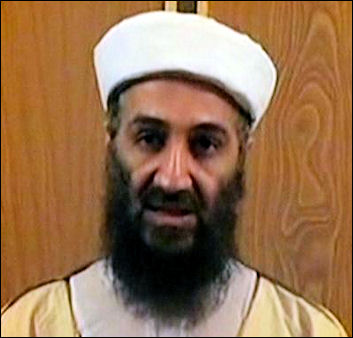
Osama bin Laden video found after his death Osama bin Laden once said that 90 percent of his battle is fought in the media. Al-Sahab ("the clouds" in Arabic) is the media production wing of Al-Qaida. The now-defunct Arabic-language magazine, Al Jihad, was published by Osama bin Laden in the 1980s before he gained infamy.
Craig Whitlock wrote in the Washington Post: “Terrorism has evolved into a war of ideas and propaganda, a struggle for hearts and minds fought on television and the Internet. On those fronts, al-Qaeda's voice has grown much more powerful in recent years. Taking advantage of new technology and mistakes by its adversaries, al-Qaeda's core leadership has built an increasingly prolific propaganda operation, enabling it to communicate constantly, securely and in numerous languages with loyalists and potential recruits worldwide. [Source: Craig Whitlock, Washington Post, June 24, 2008]
“Every three or four days, on average, a new video or audio from one of al-Qaeda's commanders is released online by as-Sahab, the terrorist network's in-house propaganda studio. Even as its masters dodge a global manhunt, as-Sahab produces documentary-quality films, iPod files and cellphone videos. In 2007 it released 97 original videos, a sixfold increase from 2005. (As-Sahab means "the clouds" in Arabic, a reference to the skyscraping mountain peaks of Afghanistan.)
“When Osama bin Laden wants to deliver a speech, a trusted video cameraman is summoned to a safe house somewhere in Pakistan, according to U.S. counterterrorism officials and analysts. The video file is then edited, stored on a tiny computer memory stick and given to a human courier. The memory stick usually passes through several sets of hands to disguise its route, until an operative finally sits down in an Internet cafe and saves the data to a password-protected Web site.
“Analysts said that as-Sahab is outfitted with some of the best technology available. Editors and producers use ultralight Sony Vaio laptops and top-end video cameras. Files are protected using PGP, or Pretty Good Privacy, a virtually unbreakable form of encryption software that is also used by intelligence agencies around the world...Speeches by bin Laden and other al-Qaeda leaders can appear online less than a week after being recorded, although it usually takes two to three weeks before they are released, officials and analysts said.
"We all think of them as a bunch of guys living in caves, and Miran Shah may be the other side of the moon," a senior U.S. counterterrorism official, referring to a Pakistani town near the Afghan border that has served as a refuge for al-Qaeda operatives, told the Washington Post. "And yet their guys are all communicating on laptops, just like I do from one of the most wired buildings in Washington." Al-Qaida has made some effort to reach Western audiences. Videos tapes released by Osama bin Laden and Ayman al-Zawahiri often have had English subtitles.
Revival of Al-Qaida Media
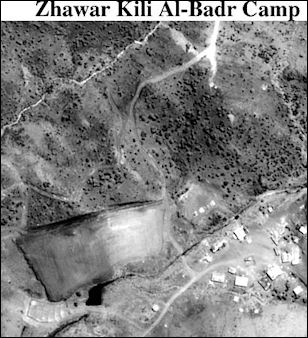
Zhawar Kili Al-Badr Camp “In 2005, al-Qaeda's propaganda machine was seriously ailing,” Craig Whitlock wrote in the Washington Post. “Al-Jazeera, the terrorist group's channel of choice, had stopped airing al-Qaeda videos in their entirety. Many bin Laden followers complained bitterly in Web forums that al-Jazeera was distorting the leader's speeches by playing clips out of context. Meanwhile, the U.S. government and its allies were successfully pressuring Internet service providers to shut down Islamist Web sites. Many key technology experts had been captured or killed. The founder of one influential Web forum was killed in Saudi Arabia. October 2005, British police arrested Younis Tsouli, a Moroccan-born webmaster who had played an instrumental role in building communication networks for Iraqi insurgents and other al-Qaeda affiliates. [Source: Craig Whitlock, Washington Post, June 24, 2008]
“About the same time, al-Qaeda supporters designed a new propaganda distribution network called al-Fajr Media Center. Al-Fajr, which means "dawn" in Arabic, eventually linked dozens of anonymous webmasters around the world. U.S. intelligence officials and analysts still know very little about the network's inner workings. But over time, it has taken over the dissemination of online propaganda for scores of radical Islamist groups. In addition to as-Sahab, it distributes material for al-Qaeda affiliates in Iraq, Somalia, North Africa and Yemen, as well as for the Taliban and other militant groups. Many of the videos ultimately are subtitled in English as well as German, Italian, French, Pashto, Turkish and other languages.
“Al-Fajr is heavily decentralized, with its webmasters generally unaware of one another's true identities for security reasons, intelligence analysts said. It also has separate "brigades" devoted to hacking, multimedia, cybersecurity and distribution. The network receives propaganda material from individual terrorist groups and then posts it online. Each release is announced on popular Islamist Web forums, where thousands of members are encouraged to copy the videos and redistribute them on other sites.
“The Web forums are password-protected and highly regulated. In certain sections, only high-ranking moderators have the authority to post material -- such as bulletins announcing a new bin Laden video. As a result, al-Fajr and others can quickly spot fake material, ensuring that the propaganda maintains a high level of reliability and consistency, analysts said. "By controlling that content, al-Fajr Center can make sure everybody who is getting that information knows they're getting it from an authentic source," said Josh Devon, senior analyst at the SITE Intelligence Group, a private firm that monitors Islamist terrorist groups online and serves as a consultant to U.S. and foreign government agencies. "It'd be extremely difficult for the CIA or another intelligence agency to introduce credible and effective counterpropaganda." Al-Fajr is extremely security-conscious, Devon said. It distributes a manual called the "Technical Mujahid," which advises how to cover electronic footprints and avoid infiltration.
According to IntelCenter, a terrorism research firm, the number of videos produced by as-Sahab soared in the mid 2000s from one every two months in 2002 to a new video every 3½ days on average in 2007
Adam Gadahn, American Star of As-Sahab
Adam Gadahn Craig Whitlock wrote in the Washington Post: One of the more visible and intriguing faces on al-Qaeda videos is that of Adam Gadahn, a California native and convert to Islam who moved to Pakistan a decade ago. Gadahn, who calls himself "Azzam the American," first appeared in a video in 2005, when he threatened attacks on Los Angeles. He's been cast as the star of several productions since then, and analysts said it is clear that al-Qaeda's leadership turns to him for advice on how to address a U.S. audience. [Source: Craig Whitlock, Washington Post, June 24, 2008]
"I don't know how well he actually understands the U.S. market, but he understands it a whole lot better than any of them," the senior U.S. counterterrorism official told the Washington Post. "Al-Qaeda doesn't have a whole lot of choice. If they want to know something about the U.S., they either go to Gadahn or to Wikipedia."
While many analysts have dismissed Gadahn as a bit player, his videos are wildly popular among al-Qaeda foot soldiers in Europe. British police, for instance, regularly find copies of Gadahn's videos during their investigations of homegrown terrorist cells, said Kohlmann, the consultant, who works as a senior investigator for the NEFA Foundation, a terrorism research group based in Charleston, S.C. "His slogans become mantras for these people," Kohlmann said. "They find Gadahn to be a heroic figure, as a symbol, as a leader."
Al-Qaeda Jihadist Animation Targets Children
In 2011, the BBC reported: “Al-Qaeda supporters say they are making an animated children's film aimed at inspiring them to take up armed struggle with the militant group. Stills were published on the Arabic-language al-Shamouk jihadist website, reported Qulliam, a London-based "counter extremism" think tank. It said the movie would show "heroic acts" including "armed engagements".But a US government adviser on counter-terrorism expressed doubt that such a cartoon was really being made. [Source: BBC July 21, 2011]
“The post on the al-Shamouk website was authored by someone calling himself Abu al-Laith al-Yemen, Quilliam said. It quoted him as saying: "The cartoon movie al-Qaeda in the Arabian Peninsula is a very exciting story that tells the facts about who let down the Islamic religion and the Prophet... "It aims to catalyse the youth and the children to follow the steps of Islamic jihadist figures. It includes real incidents and features heroic actions by the mujahideen in the Prophet's peninsula. "These incidents include raids, armed engagements and assassinations." The film was an "alternative to the poison that is broadcast by other TV channels to our children and youth", he added.
"Whether or not this movie actually appears, this shows a significant development in al-Qaeda's attitude to the media and to recruitment," Noman Benotman, a former jihadist and Quilliam analyst, told the BBC. "They are trying out new methods to make terrorism exciting to young people and even to children." But the plan "may backfire", Mr Benotman added. "Many Muslim parents will see this as a direct attempt by al-Qaeda to create divisions within families and to undermine the authority of parents." He said the purported movie could also be evidence that a discredited al-Qaeda was having to resort to "gimmicks".
Will McCants, a scholar of militant Islamism and US government counter-terrorism adviser, told readers of his Jihadica website he was "very sceptical" it was a real product. "But if it's legit and anywhere near like the purported screen shots and promotional banner below, it would indicate that [al-Qaeda in the Arabian Peninsula] is becoming even more sophisticated in its efforts to reach out to youth. "Now they just need some action figures."
See Terrorism
Irhabi007
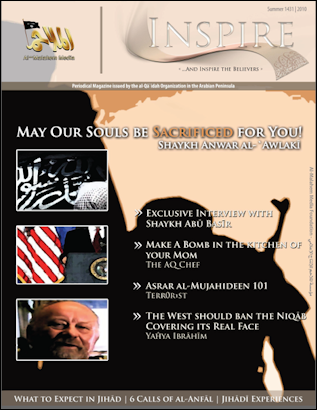
Inspire magazine cover
Younis Tsouli, a Moroccan living in London with his diplomat father who sometimes attended the Shepherd's Bush mosque near Uxbridge Road, investigators say, served as a pioneering cyber-operative for Al Qaeda, who oversaw some missions and was at the hub of other plots. His alleged alter ego, Irhabi007, appeared on radical sites in 2003. His first real coup came in May 2004 when he copied and disseminated a video of Zarqawi beheading Nicholas Berg, an American contractor in Iraq. Two months later, he hacked into the servers of the Arkansas highway department to distribute Zarqawi videos. [Source: Sebastian Rotella, Los Angeles Times, April 16, 2007]
Sebastian Rotella wrote in the Los Angeles Times: “Irhabi007 came up with revolutionary ways of finding space to disseminate big multi-media files without getting caught. He allegedly posted materials about bomb-making and hacking, trolled Web pages of U.S. soldiers in Iraq for tips on targets, discussed a plot against the U.S. warship Kennedy.” "He had a flair for marketing, advertising," Evan Kohlmann, a private anti-terrorism consultant who helped investigators track him, told the Los Angeles Times. "It was all so professional.... He had a unique, bloodthirsty brand of humor."
In one online exchange, Irhabi007 celebrated the slaying of a U.S. diplomat in Iraq, according to a transcript. The victim's name "sounds Jewish," he jeered. "Not any more! LOL. !!!! nice catch. (:! NEXT." When Kohlmann proposed an online dialogue, he answered: "Dear Evan: I don't do interviews. If you wish to discuss anything, then the forum is a good platform."
A Zarqawi aide gave Irhabi007 instant notoriety in October 2004 by praising his talents in an online statement. Zarqawi's Al Qaeda in Iraq organization started sending him videos and asking him to post them, according to Bosnian court documents. In addition to acting as "media guy" for Al Qaeda in Iraq, he also allegedly began recruiting fighters and assisting with their journeys, Kohlmann said. "He was working like a telephone operator, putting people in touch with the Zarqawi organization," Kohlmann said.
Al-Qaida Web Sites
Al-Qaida supporters use dozens of Islamist sites to spread Al-Qaida statements. Al-Qaida-linked groups also set up their own sites, which are frequently forced to move after the are shut down by Internet service providers. Officials in the United States and elsewhere have long been concerned about sites associated with al-Qaeda. Those sites have been used to call for violence against Western targets and to try to recruit Islamist extremists to carry out attacks.
There are hundreds of different addresses for Al-Qaida alone at any given time. Global Islamic Media Front is one Al-Qaida-linked web-based organization. The sites not run directly by Al-Qaida serve its purposes by inspiring and recruiting jihadists and sympathizers. Al-Qaida has placed ads on non-Al-Qaida websites seeking help in making web sites and videos.
Al-Qaida-sympathetic sites include web-based television , Internet chat rooms and “news” sites that in some cases serve as virtual training camps for terrorism and guerilla warfare. Israeli cyberterrorism expert Gabriel Weimann told Reuters: “Al-Qaida has launched a practical website that shows how to use weapons, how to carry out kidnappings, how to use fertilizer to make bombs.” An Internet magazine posted by an Al-Qaida affiliate in Iraq in 2005 urged Muslims to join the jihad and rid Iraq of infidels and apostates (a.k.a. Americans). The colorful,, well-designed magazine was called “Zurwat al-Sanam” (Arabic form “The Tip of the Camel’s Hump).
Abdulmanam Almushawah, head of a Saudi program that tracks militant Islamist websites, told AP the number of English-language sites sympathetic to Al-Qaida rose from 30 in 2002 to around 200 in November 2009. By contrast the number of such sites in Arabic dropped from from around 1,000 in 2002 to 50 in 2009 primarily because of efforts by counter-terrorist operations to shut them down.
Inspire, Al-Qaida Internet Magazine

Al-Qaida camps
In July 2010 Yemen-based Al-Qaeda in the Arabian Peninsula's (AQAP) launched Inspire magazine — a 67-page publication available from jihadist forums that are sometimes password-protected or otherwise difficult to access — according to SITE Intelligence, a US service that monitors Islamist websites. [Source: W.G. Dunlop, AFP, July 12, 2010]
W.G. Dunlop of AFP wrote: The magazine is packed with sleek pictures of Al-Qaeda leaders and bright graphics. Its cover features an image of a silhouetted man with a rifle under the headline "May Our Souls Be Sacrificed For You!," an article attributed to radical US-Yemeni cleric Anwar al-Awlaki. With article titles such as "Make a Bomb in the Kitchen of Your Mom" by the "The AQ Chef," or a packing list included in "What to Expect in Jihad," parts of the magazine have a friendly, if extremist, scouting manual feel. But despite its sometimes-friendly tone and snazzy layout, its intent is, very literally, deadly serious. The "Make a Bomb" article notes that a device made in "one or two days could be ready to kill at least ten people," while one made in a month "could kill tens of people
The article, which addresses "Muslims in America and Europe," then details the construction of an explosive device using sugar, crushed match heads, a pipe, a Christmas tree-type light, a battery and a clock. In another article, the magazine provides instructions on sending and receiving encrypted messages using a computer programme called "Asrar al-Mujahedeen," or Secrets of the Mujahedeen. "Spies are actively paying attention to... emails, especially if you are known to be jihadi-minded," the article says. Thus, the programme is a better option. It also notes that "the enemy" has created a knock-off Asrar programme meant to monitor jihadi correspondence, and advises users to perform an authenticity check.
Image Sources: Wikimedia Commons
Text Sources: New York Times, Washington Post, Los Angeles Times, Times of London, The Guardian, National Geographic, The New Yorker, Time, Newsweek, Reuters, AP, AFP, Wall Street Journal, The Atlantic Monthly, The Economist, Global Viewpoint (Christian Science Monitor), Foreign Policy, Wikipedia, BBC, CNN, NBC News, Fox News and various books and other publications.
Last updated July 2012

